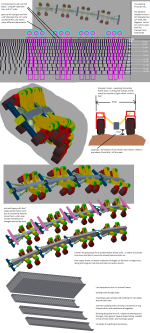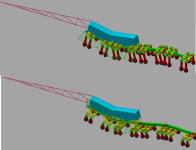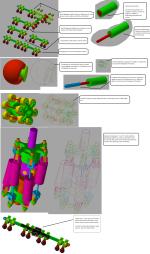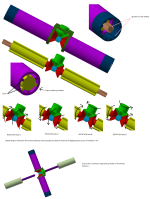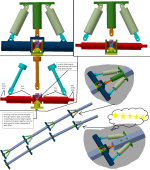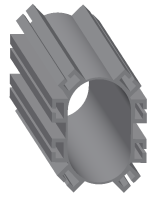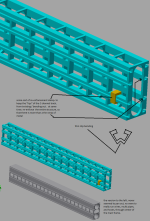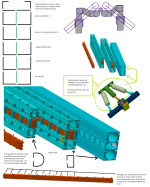have been having problems, that slowly getting worse, with random computer freezes (keyboard, mouse, screen) and requires reset of computer, bios of motherboard resetting on its own. cpu over heating. data corruption due to freezes. slowly been trying to diagnose issues, removing software, reinstalling drivers, running memory tester, cpu tests, last night / today, did format reinstall finally, and still issues, called asus up, and they RMA'ed the motherboard. hopefully all will be settled in first few days of next week. until then, hopefully i can keep on going, without a complete hardware failure.
((see attached picture first))
wheel spacing, and trying to meet a wide range of different row spacing. i got defeated. just way to many different row spacings and not enough room.
up to this point been trying to stay with a 12" x 16" main square tube frame that is approx 13 feet long. once i started trying to add different "frame works" for say a hay wagon frame work before the floor is put down, to sprayer rig setup, to simply adjusting linkages to fold/unfold implements. my thoughts have changed....
to some sort of "track setup" kinda like track lighting, were you can slide a light around on the track, but there really is no wheels / rollers / other. just metal to metal sliding. and some sort of bolt / screw to possibly fasten light in place to keep it from moving. though i think i am going to go for some sort of "double track" one lower track, to adjust wheel spacing. then an upper track. to adjust linkages that fold/unfold implements. or were you would attach frame work to turn SSTT into a wagon or like, to linkages to engine / fuel tank / etc...
problem is, not sure what type of track to use or how to even set it up.
========
i suppose for wheels and the linkages for them, i would want to be able to just undo a hand full of bolts, wires, hyd hoses, air hose, and pull entire wheel off. without having to remove a bunch of other wheels from the given track.
i really do not need a big complex track setup. just a "lip" of some sort that would allow things to slide, but not allow things to come crashing down to the ground. figure sliding will require some sort of farm jack, or chain / pulley / snatch block. or someone using a fork lift, with what ever chained to forks, or lifted up into place with a fork lift (forks on FEL as well). perhaps forks used to slide stuff across the tracks as well for adjustment.
i figure some sort of "clamp" pipe clamp, muffler clamp, or there about, or perhaps some actual holes were pins or bolts could be used.
maybe a "wedge" setup instead of clamps and/or bolts. folks been using wedges for years in wood working. hmmmsss bending, wiggling, pounding wedges out, deformed wedges...
i need space for the central hyd cylinder, (that is used for between sections) that takes up 3 to 6 feet of the approx 13 feet length of the main frame / track. so what ever ends up getting used. is going to need to compensate for that, to allow attachments around the hyd cylinder.
i will also need a way to route, wires, hyd hoses, air hoses, etc... through and around the main frame / track. and allow for connections into them wires, hyd hoses, air hoses, etc... i guess what makes sense is making this stuff, run on the outside, maybe in a U channel, or perhaps some way to zip tie everything up. errr ok zip tie bad idea, due to heat. wires on one side, fluids / air that could become extremely hot on other side of frame perhaps.
i wonder... if i went with a 8" outer diameter of the "central hyd cylinder" that is used for between sections. and went with say a 8" inner diameter 8.125" outer diameter pipe. (to allow hyd cylinder to slip in) and then for hyd hoses (say max 3000PSI), used metal pipe, and physically welded the pipe to the outside of the 8"/8.125" pipe. then did same thing for coolant hoses. instead of using rubber hoses, use a metal pipe. and welded the smaller pipes to the 8" x 8.125" pipe. and repeated for air hoses, instead of rubber, go with metal pipes, and weld. and then for Tee connections. cut into the pipe of wanted fluid / air. and then weld on some sort of Tee shaped fitting. maybe using a dremal, or grinder for the cut. "maybe a drill"
bah... as soon as i put a tee fitting / nipple that stuck out. i would be in trouble for trying to slide a wheel or something else over the area, let alone trying to place something over the area.
*rubs chin*, do i just go with "pipe hangers" that fit on the 2 sets of tracks. and hold the wires, hoses, etc... away and off the tracks... well hhmmsss... ya first hose / wire that sags to much, and "snap" there goes entire machine setting dead.
am i going to need a triple decker setup. lower track, for wheels and there linkages, middle layer wires, hyd hoses, air hoses, coolant, etc... and then top track for implement linkages, wagon connection, engine linkages. its starting to turn into a "spine" of some animal... *gulps*
alright lets go off that statement of an animal.... treat wheels like, having 2 legs. other words, wheels would be in sets. wheel directly across from given wheel ... naa... well... hmmmsss.. i need to keep with wheels on each side do not have to line up with another wheel on the other side, along with keeping possibilty of allowing wheels to be lined up (directly across from each other) possible.
would an upper case I, or rather H beam for upper and lower track work? or would i be better off with... shape something like.....
|-O
one side of H beam more of a circle, or perhaps half circle...
|-(
...................
lower frame |-( wires )-| top side of top track.
hhmmmsss i guess i could still do wedges or rather i should say spacers to deal with odd shape H beam. and pipe clamp / muffler clamp. things. but how do i route holes and ends of clamps. around the area for wires and hoses.
hhmmsss.... 2 H beams, welded together with some say 2.5" long, 1" wide, 1/4" thick strips of metal. that overlap 0.5" onto each side of each H beam.
|-|=|-|
well....
|-|-|=|-|-|
hhmmsss
-|-|=|-|-
back to...
|-|=|-|
*decides to turn monitor 90 degrees*
-|=|-
(|=|)
)|=|(
)-|-(
><>< might be something.
>|<
<> simple square tube, turned 45 degrees. maybe..
++
++ 4 pluses turned into a single square pipe in center, and 8 legs stick out.
++
++ above and turned 45 degrees maybe?
<| triangle? point is down, flat on top.
<|
<| triangles point down, flat on top?
>+<
never thought i would end up doing character art, to figure out how to build something.
time to post / save. before i loose info.
==========
